You know it’s emotions, not logical reasoning, that drives decisions, right? By evoking a particular emotion in consumers, you encourage them to take a desired action.
To elicit that emotion, you need a trigger. Where do you get that trigger? By implementing certain psychological principles in your copywriting.
Expert work with all those psycho principles in content is known as neuromarketing, and you’re on the right page to learn how to make the most out of it.
Contents
- What is neuromarketing?
- Why use neuromarketing in your copywriting?
- What are neuromarketing examples?
- What neuromarketing techniques work to drive action?
What is neuromarketing?
Neuromarketing merges neuroscience, psychology, cognitive science, and marketing to understand and influence consumer behavior. It uncovers subconscious and emotional factors impacting choices.
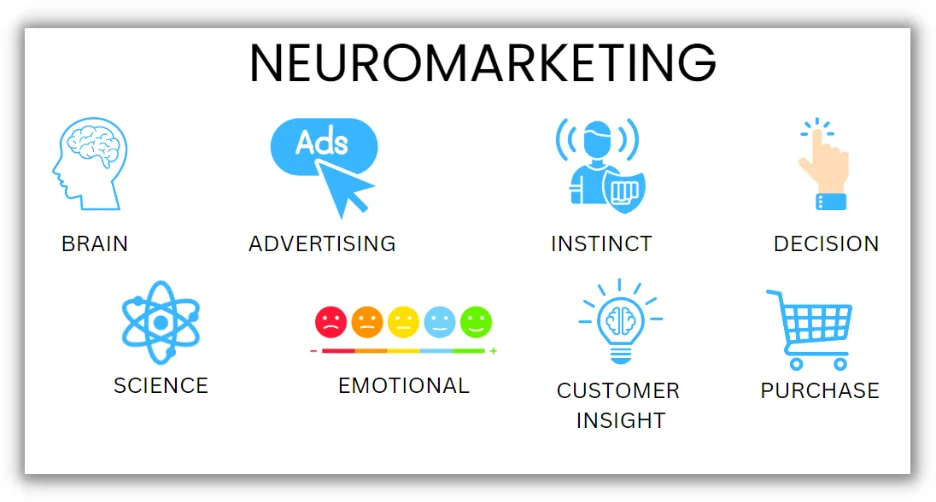
Specialists use neuromarketing techniques to study the human brain and predict decision-making behavior. Let’s explore why you should implement neuromarketing techniques in your copywriting.
🧠 Speaking of neuromarketing… Get our free guide >> 26 Brilliant Ways to Use Psychology in Your Copywriting (with Examples)
Why use neuromarketing?
Why apply neuromarketing techniques to your copywriting and other marketing activities? Here are some benefits:
- Better understanding of consumer behavior: Neuromarketing unveils emotions, attention, and memory triggers in consumer behavior, thus enabling the creation of impactful marketing messages.
- More effective ways to optimize website design: By studying eye-tracking data and user behavior, you can optimize design elements to encourage desired actions.
- Improved personalization and targeting: Uncover individual preferences and emotional triggers to tailor messages and offers for specific consumer segments.
- Enhanced content creation: Understanding how the brain processes information helps you craft compelling stories that evoke emotions and drive engagement.
Numbers speak volumes. According to the stats, neurological engagement can increase advertising effectiveness by up to 19%. We also know that 63% of users remember brands that tell stories, and 74% of consumers trust businesses more after reading positive reviews.
Neuromarketing examples in copywriting
You don’t need to be a scientist. By analyzing research insights, you can identify neurological responses, emotional triggers, and attention patterns influencing your target most. Apply them to tailor your overall marketing strategy and drive purchasing decisions.
Here are some examples of neuromarketing in action.
1. Two odd numbers in headings
The brain loves numbers. They make content more digestible and provide order to chaos.
Why two numbers? To double the effect: The first one grabs attention, and the second one explains why read the content.
Why odd numbers? It’s about psychology again: Even numbers look friendlier, while odd ones are more thought-provoking. It doesn’t mean you should use only the odd numbers. Consider the effect (emotion) you want to evoke with your content.
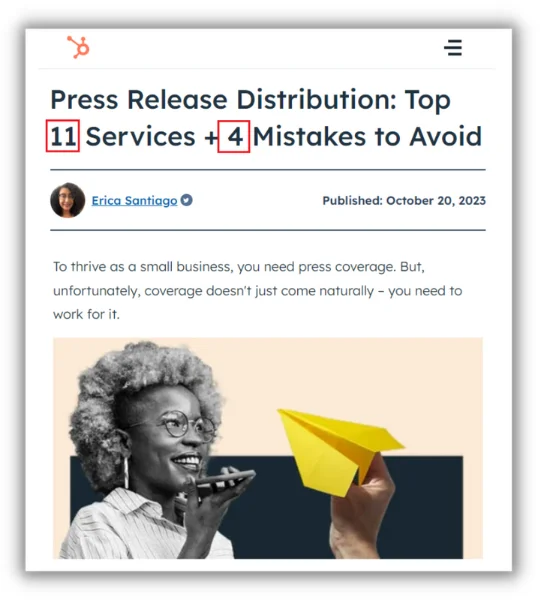
2. Questions in subheads
Online readers scan the content to understand if it’s what they need. Format subheads as questions to clarify what readers will learn, spark curiosity, and appeal to FOMO.
Questions encourage scanners to continue the investigation to ensure they haven’t missed anything and satisfy their social instinct.
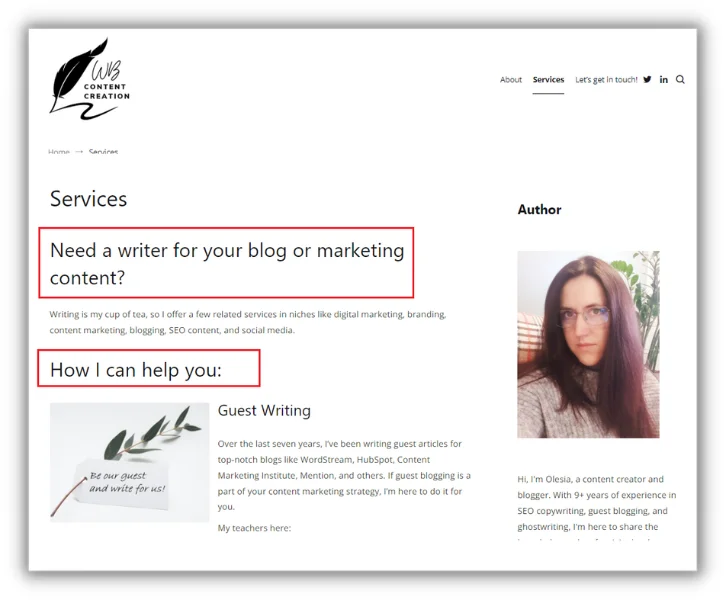
3. The Socratic method in introductions
Post three questions or statements in a row to engage users in communication.
Why three?
The human brain grasps three the best, so the sequence of three makes it easier to remember the information. Writers do love the Rule of Three: It builds the rhythm and keeps readers glued to your message.
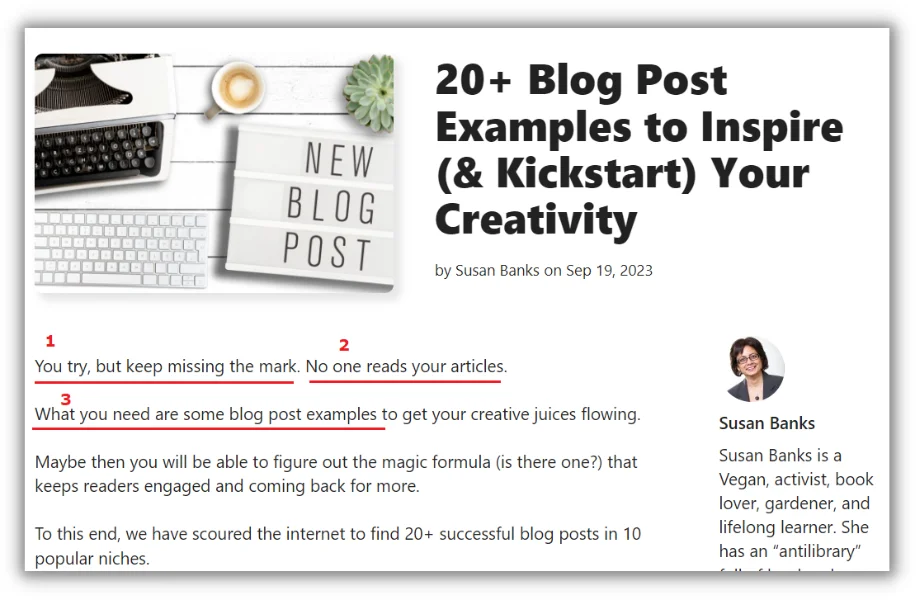
4. Power words and active verbs in content
Power words are persuasive and descriptive. They trigger an emotional response, make readers experience different states, and push them in particular directions.
Power words are adjectives indicating and explaining your statements. Like these:
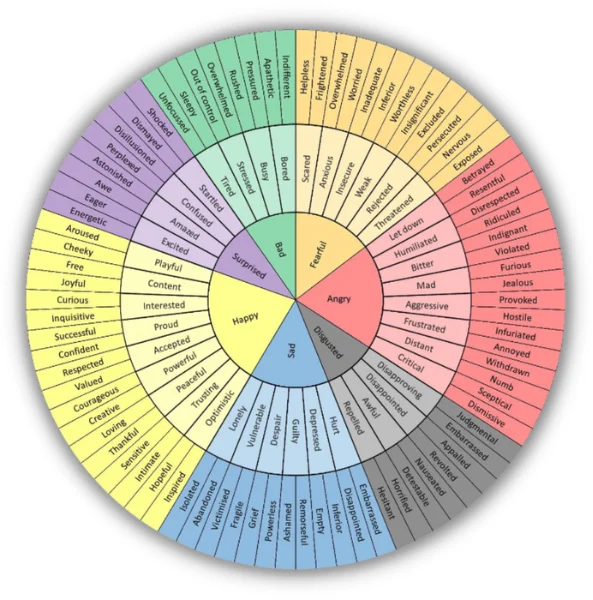
This wheel chart by Geoffrey Roberts shares 150+ emotion-triggering words you can use in your copies.
Also, power words are strong verbs that add action to your message.
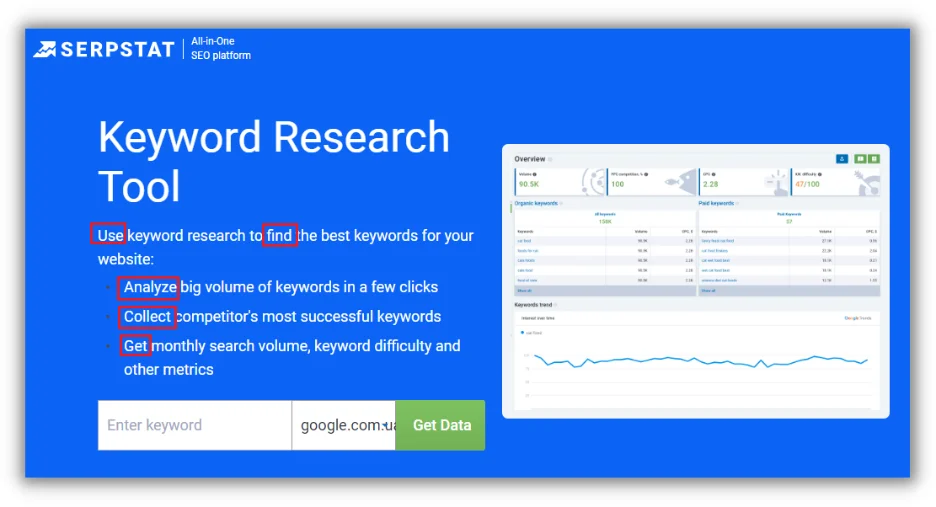
📚 Free guide download >> 135 of the Best Words & Phrases for Marketing with Emotion
5. Sensory language when appropriate
Sensory words are lexical items appealing to the human physical senses. When reading the content with such words, users “see,” “hear,” “touch,” “smell,” or “taste” it.
Sensory words are powerful because they paint scenes in readers’ imagination. They activate the somatosensory cortex, making us recognize these words faster. Sensory words make readers feel as if they are in your story, thus remembering your message better.
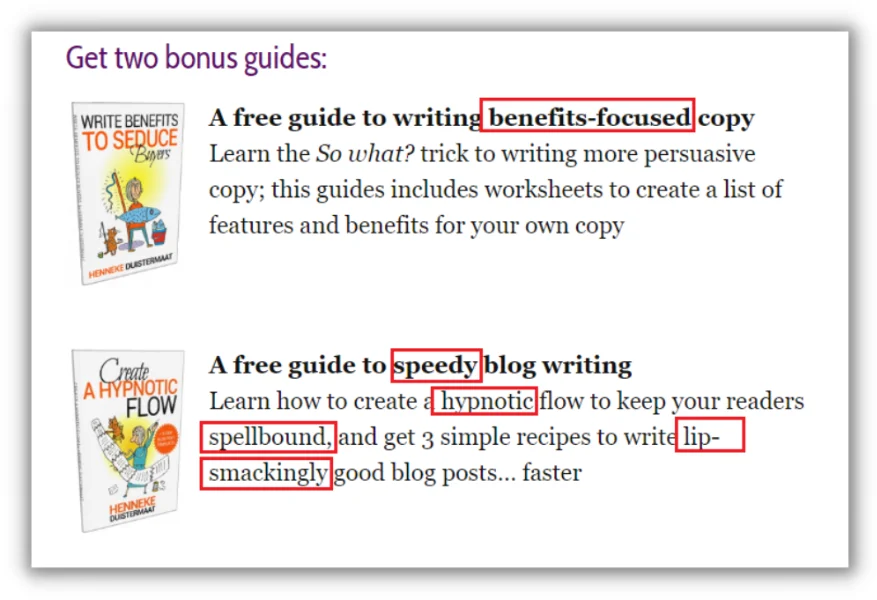
Remember to use these principles ethically and transparently, respecting consumer trust and expectations.
20 neuromarketing techniques to encourage desired actions
With the above emotional triggers in mind, include the following neuromarketing principles in your copywriting to make it work.
1. Authority
Position your brand as an industry expert through research findings, data, and credible collaborations.
Why do you think influencer marketing works? Users subconsciously believe famous people can’t go wrong because they choose the top products/services for themselves.
But: Authority isn’t only about top celebs with millions of subscribers on social media. Think of micro- or nano-influencers: They have the most loyal audience. Collaborate with experts in your niche: CEOs, top managers, or specialists who know what they talk about.
2. Common enemy
Struggling with a common enemy unites people. It’s not only about physical enemies but pains, complexes, or bad habits, as well. Concepts like hunger, poverty, diseases, or climate change are also here.
What’s your brand’s mission? Is it socially responsible?
Users are loyal to businesses that align with their identities and share the same values. Prescribe this element and incorporate corresponding meanings into your content strategy.
Create a positive ethos for your brand: Why does it matter? Why should people listen to your message?
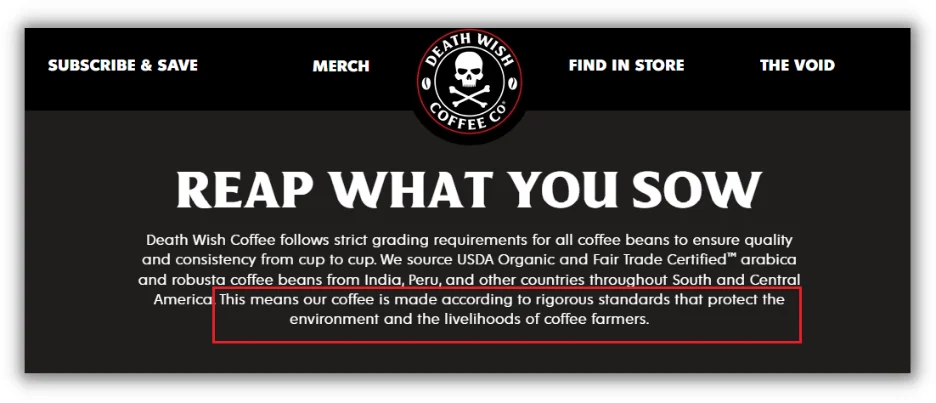
3. Consistency and commitment
Encourage commitment through regular communication, loyalty programs, and subscription services.
The more you interact with a customer, the more they trust your product, service, team, or individual specialist. The challenge is to establish a productive interaction and get a response.
You can initiate a dialog in messengers, newsletter emails, or online chat. Tests, quizzes, and other interactive content also work.
4. Cross-marketing
This trigger is about the intersection of several target audience segments. Organize your content so website visitors see your minor products with major ones.
In ecommerce, we know this trick as “You may also like” or “Buy together:” When examining a product description, a customer sees related items they might also want to buy.
Informative or educational websites address the same principle with content elements like “Related articles,” “Extra read,” “Editor’s Pick,” etc.
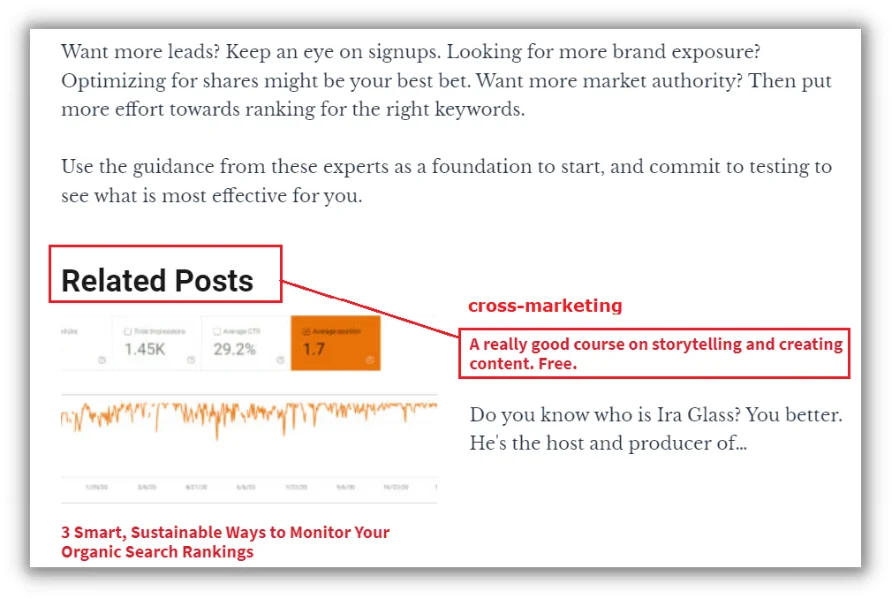
5. Framing
Different framing techniques impact perception:
- Comparative framing: Highlight superiority over competitors.
- Loss aversion framing: Use phrases like “limited time offer.”
- Goal framing: Present your product as a solution to specific goals.
- Attribute framing: Highlight appealing features.
- Time framing: Encourage immediate action by prescribing deadlines (“today only,” “first three subscribers will get…,” “two hours left,” etc.)
6. Flattery
Incorporate genuine praise or appreciation to build rapport. Personalized emails and positive feedback boost customer loyalty.
Incorporate genuine praise or appreciation to build rapport. Personalized emails and positive feedback boost customer loyalty.
You can personalize a customer by name, profession, age, social status, or hobbies. It is realistic to find a suitable appeal for every niche and customer segment.
When a subscriber, prospective client, or webpage visitor sees a familiar hook, they subconsciously realize you’re talking to them.

Their response to a personalized greeting will be faster and warmer than to generic wording.
7. Greed
Appealing to one of the core human weaknesses helps boost engagement and raise sales. Promotions, discounts, and contests encourage prospective customers to open their wallets.
Greed pushes subscribers to invite friends to groups, repost social media content, and share links. Spontaneous purchases are also here.
Palmary examples of using this neuromarketing principle: Black Friday and Cyber Monday campaigns most brands organize.
8. Herd behavior
Every person is a unique individual, and no one wants to recognize themselves as part of a so-called “herd,” but:
Social instinct is among the top three basic ones, so we can’t resist appreciation and a sense of belonging to some group. Most websites appeal to this instinct with messages like:
- “100,000+ downloads already”
- “Rating: 4.5/5 stars”
- “With over 300k subscribers and 4 million readers, we are…”
When a user sees such messages, they subconsciously approve your offer. After all, so many people can’t be wrong, huh? So, everything is okay with the product/service you have for them.
9. Intrigue
This one is like cliffhangers in a movie series, cutting off episodes at the most intriguing moment to motivate the audience to come back and watch the next one.
A few examples:
- In next week’s video, I will tell how I’ve my first 100 thousand subscribers.
- I’ve become popular by a happy accident, but I will talk about it a little later.
- I have to pause now; please wait for the second part in tomorrow’s release.
10. Justification
It is easier to push a site visitor to the desired action if you explain the why’s behind it. Reveal all the benefits of purchasing in this particular place and time.
Collect all available arguments and added values. Simplify messaging, designs, and instructions to minimize cognitive load.
11. Instant benefit
A sales funnel is a core marketing instrument, but sometimes it’s possible to get loyal clients once they land at your website. Think of a perk (a here-and-now benefit) to offer to visitors:
A free template, checklist, or ebook can become the lead magnet to hook a user to stay with you and become your client.
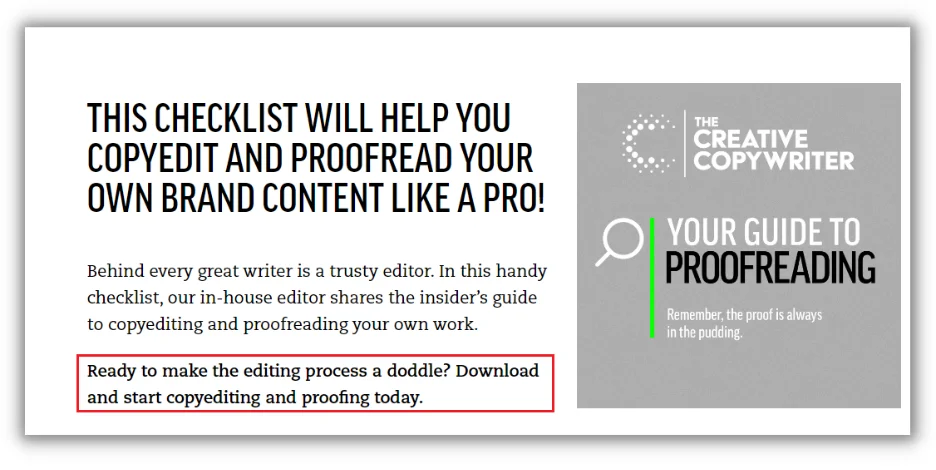
12. Novelty
Appeal to the brain’s attraction to novelty by introducing innovative elements and collaborations.
Please note that the word “new” itself doesn’t work. The trigger will do the job if your offer is truly fresh, unusual, and unique. Think of it as your UVP (unique value proposition).
What makes you different from competitors? What can you do for a customer that they don’t?
13. Reciprocity
The principle of reciprocity suggests that when you provide value to your audience, they are more likely to engage with your brand. Offer free resources, trials, discounts, or personalized recommendations.
The catch is you’ll ask something in return. For example, an email address to send informative newsletters with compelling content, encouraging to buy.
But remember: Reciprocity works when used right. It’s critical to know your limit, especially today when the audience is fed up with tons of “gifts” and offers they find in inboxes daily. Being too aggressive with marketing messages, you risk unsubscriptions and negative reactions.
Be honest and write about what you’ll send users once they share emails with you.
14. Result
The common example is content assets presenting “before” and “after” to users. Photos or videos demonstrating how your product works do the magic!
The trick is to present everything in as much detail as possible so that people can see the difference between the first and second versions.
“Before” and “after” is not the only way to demonstrate results. Case studies do wonders in all niches, too. Working with the same principle, they are the format where you can show results with a text.
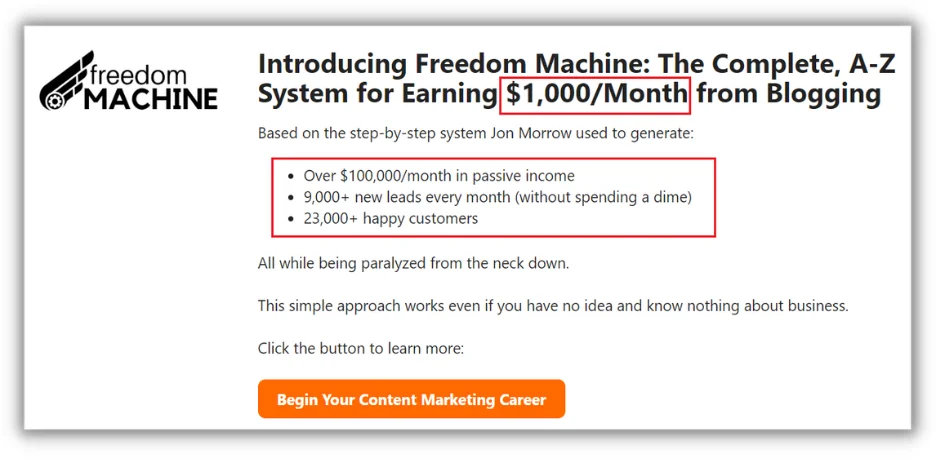
15. Scarcity
Create urgency through limited availability tactics. Ethically use limited quantity, time-limited offers, and scarcity techniques to drive action.
It’s about FOMO again: People don’t want to miss an offer that will be unavailable soon.
Two options here:
- It’s a super popular product/service of extra quality.
- It’s originally for a narrow circle of “chosen ones.”
Scarcity works with any restrictions: color, features, time, date, quantity, cost, etc. When using this trigger, it’s critical to keep your word. If sales close tomorrow, that’s what should happen.
16. Social proof
Use testimonials, endorsements, ratings, and reviews to establish trust and credibility.
Testimonials remain the most popular social proof, but it’s critical to make it trustworthy. Today’s users aren’t as naive as some marketers continue to believe: They won’t trust comments from John Doe with stock photos in avatars.
Share reviews from real people: Make videos, provide active links to their social media profiles, use signed and stamped thank-you letters from partners, etc.
Another instrument to boost social proof for users is your contact information. Many websites hide it, placing nothing but a standard contact form instead.
Wrong.
It hurts E-E-A-T factors and kills user loyalty and trust. Your address, phone number, email, and active social media accounts are worth placing on the website.
Certificates, ratings, budges–all they confirm your expertise and emphasize your responsibility and integrity in customers’ eyes.
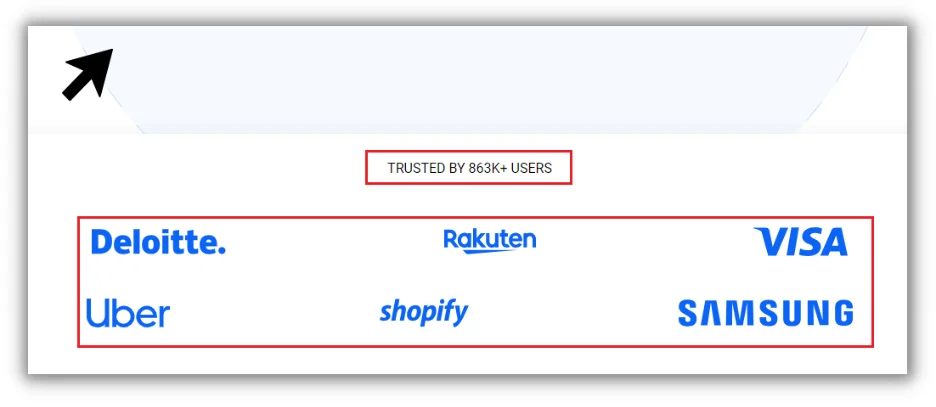
17. Specifics
It’s still an issue for many websites. They continue generating vague content assets, bringing words but no value.
Compare:
- “We sell the best windows in Chicago!”
- “Our energy-saving windows keep 93.4% of heat in your apartment.”
Yes, the example is a little hackneyed, but numbers and facts work better than sophisticated metaphors when it comes to converting traffic into leads.
Even if your niche is info products, customers want to know how long it will take to get results.
18. Storytelling
Harness storytelling’s power to evoke emotions, build connections, and make your brand memorable.
The human brain operates with stories:
- It retains 70% of information through them, while only 10% comes from data and facts.
- It responds better to narratives as they activate brain areas responsible for experiences.
- Combining data with a story increases info retention from 5-10% to 67%.
The secret is that stories don’t impose anything but, at the same time, bring the right idea to readers. Your task is to build a story in a way readers would choose your business over the others.
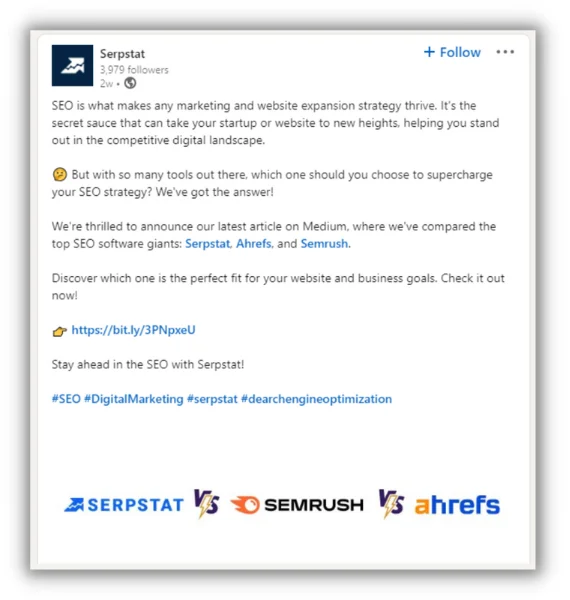
19. Upsell
This trigger serves a specific purpose: Make a customer buy more than they planned.
The oldy-moldy “Buy two–and take the third one for free” hook still works, grabbing even the savvy customers who understand the trick. Indeed, it’s hard to resist the temptation to get a free product.
20. More emotional triggers
Here are some additional emotional triggers you can use in your copywriting:
- Trust: Building credibility and reliability.
- Fear: Tapping into common anxieties or concerns.
- Belonging: The need to be part of a community or tribe.
- Curiosity: Piquing interest to learn more.
- Pride: Targeting one’s self-esteem and accomplishments.
- Guilt: Reminding the audience of a problem or responsibility.
- Urgency: Creating a sense of limited time or availability.
- Relief: Offering a solution to a problem or pain point.
- Anticipation: Building excitement for what’s to come.
- Validation: Confirming a reader’s thoughts or beliefs.
Use neuromarketing responsibly
Neuromarketing offers powerful techniques to enhance your strategies, resonating with audiences. Apply emotional triggers and psychological principles to SEO content and promo campaigns, and the result will surprise you.
But remember: Not all principles are universal, so do your best to test and iterate what works best for your audience.
Explore deeper insights, such as subconscious cues and neural engagement, to refine your strategies further. And try these other advertising techniques, too.
About the author
Olesia Filipenko is a seasoned content writer who offers ghostwriting, SEO writing, and blogging services. She works with B2C businesses, providing digital marketing content that increases their search engine visibility. Check out her website WritingBreeze or her LinkedIn to learn more.







